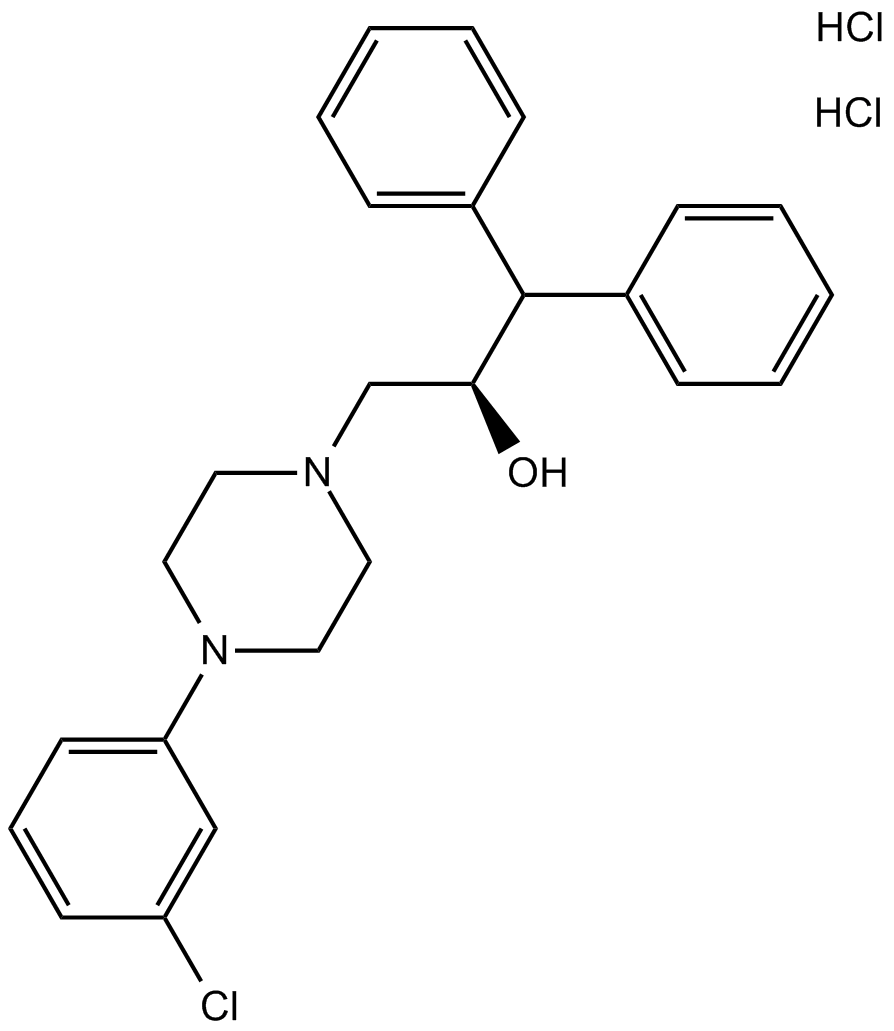BRL-15572 dihydrochloride |
| Catalog No.GC16226 |
BRL-15572 is a selective antagonist of h5-HT1D, displays high affinity for h5-HT1D receptors.
Products are for research use only. Not for human use. We do not sell to patients.

Cas No.: 193611-72-2
Sample solution is provided at 25 µL, 10mM.
BRL-15572 2Hcl is a 5-HT1D receptor antagonist with pKi of 7.9, also shows a considerable affinity at 5-HT1A and 5-HT2B receptors, exhibiting 60-fold selectivity over 5-HT1B receptor. IC50 Value: 7.9(pKi)Target: 5-HT1D Receptorin vitro: BRL-15572 displays high affinity and selectivity for h5-HT1D receptors. BRL-15572 has 60-fold higher affinity for h5-HT1D than 5-HT1B receptors. BRL-15572 binds to h5-HT1B and h5-HT1D receptors with pKB of less than 6 and 7.1, respectively. BRL-15572 stimulates [35S]GTP γ S binding in both cell lines, with potencies that correlated with their receptor binding affinities in both h5-HT1B and h5-HT1D receptor expressing cell lines. BRL-15572 reveals receptor binding affinities for 5-HT1A, 5-HT1B, 5-HT1E, 5-HT1F, 5-HT2A, 5-HT2B, 5-HT2C, 5-HT6 and 5-HT7 with pKi of 7.7, 6.1, 5.2, 6.0, 6.6, 7.4, 6.2, 5.9 and 6.3, respectively. In the h5-HT1D cell line, both BRL-15572 (1 μM) shifts the 5-HT concentration response curve with pKB of 7.1, respectively. BRL-15572 does have moderately high affinity at human 5-HT1A and 5-HT2B receptors.in vivo: In diabetic pithed rats, administration of the selective 5-HT1D receptor antagonist BRL-15572 (2 mg/kg) does not modify the decreased HR induced by vagal electrical stimulation. The effects of L-694,247 (50 μg/kg), a selective agonist for non-rodent 5-HT1B and 5-HT1D receptors, on the vagally induced bradycardia are not apparent after pretreatment with BRL-15572.
References:
[1]. http://en.wikipedia.org/wiki/BRL-15,572
[2]. Fujii H, Takatori S, Zamami Y, Hashikawa-Hobara N, Miyake N, Tangsucharit P, Mio M, Kawasaki H.Adrenergic stimulation-released 5-HT stored in adrenergic nerves inhibits CGRPergic nerve-mediated vasodilatation in rat mesenteric resistance arteries.Br J Pha
[3]. González-Hernández A, Manrique-Maldonado G, Lozano-Cuenca J, Mu oz-Islas E, Centurión D, Maassen VanDenBrink A, Villalón CM.The 5-HT(1) receptors inhibiting the rat vasodepressor sensory CGRPergic outflow: further involvement of 5-HT(1F), but not 5-HT(1A)
[4]. Rocha-González HI, Blaisdell-López E, Granados-Soto V, Navarrete A.Antinociceptive effect of 7-hydroxy-3,4-dihydrocadalin isolated from Heterotheca inuloides: role of peripheral 5-HT serotonergic receptors.Eur J Pharmacol. 2010 Dec 15;649(1-3):154-60. Ep
[5]. González-Hernández A, Mu oz-Islas E, Lozano-Cuenca J, Ramírez-Rosas MB, Sánchez-López A, Centurión D, Ramírez-San Juan E, Villalón CM.Activation of 5-HT1B receptors inhibits the vasodepressor sensory CGRPergic outflow in pithed rats.Eur J Pharmacol. 2010
Average Rating: 5 (Based on Reviews and 13 reference(s) in Google Scholar.)
GLPBIO products are for RESEARCH USE ONLY. Please make sure your review or question is research based.
Required fields are marked with *




















